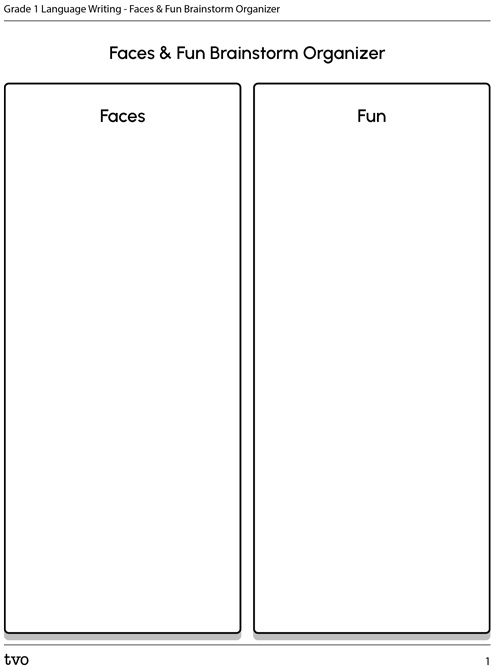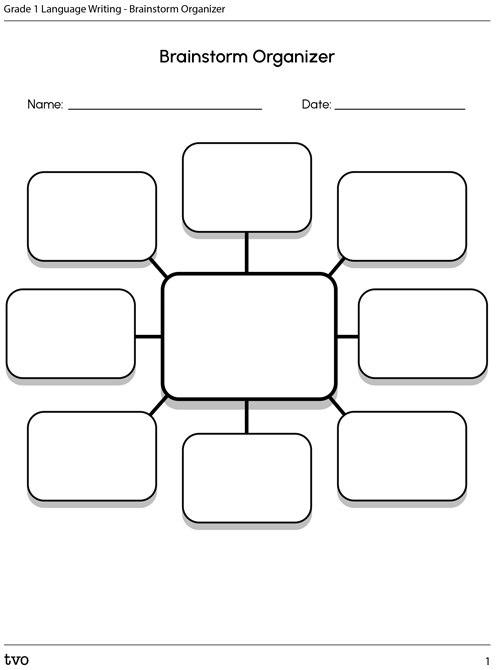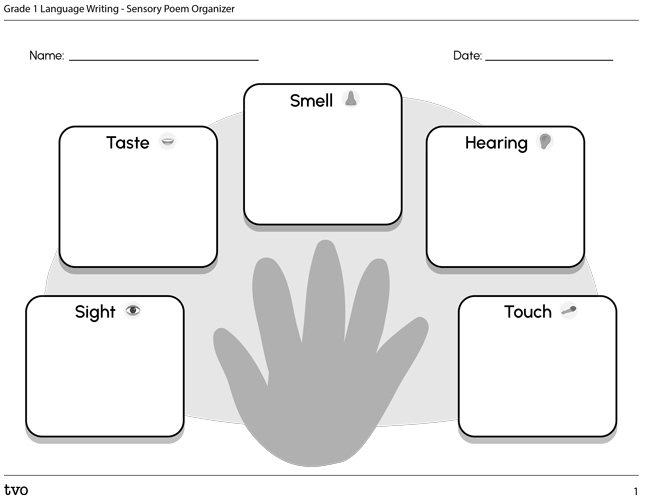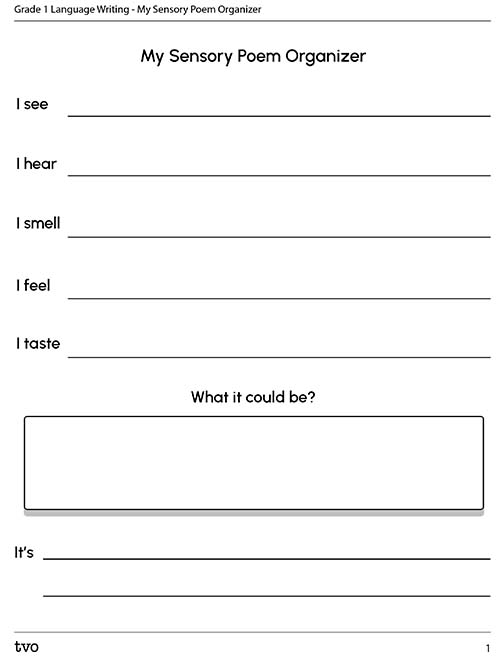Minds On
Exploring poetry
Today we are going to explore poetry. Do you know what a poem is? Share your ideas with a partner if possible.
What is poetry? Poetry is a group of words that show a feeling or tells an idea. It is a type of writing just like opinion writing and short stories. There are many types of poems and many styles of poetry. Did you know that lyrics to songs are poems? Let’s read aloud some examples of poems.

Bananas
A banana can be very sweet.
It is quite a wonderful treat.
If it’s yellow, it is best.
If it’s green, it needs some rest!

School Poem
Scholastic
Caring
Helpful
Outside fun
Opportunities
Love to learn

Toothpaste
I hear the swish, swish, swish
I smell something fresh
I see foaming bubbles
I feel my teeth getting clean and smooth
I taste something minty fresh
What could it be?
It’s toothpaste!
What is the purpose of poetry?
A poem can do many things. A poem can:
- tell a story
- be funny
- share feelings
- describe something
What form does a poem take?
Poems come in many shapes and sizes. A poem can:
- rhyme or not rhyme
- be about anything
- be funny and silly
- be fun to write
There are many different kinds of poems.
In this learning activity, you will have the chance to create some of your own poems as we explore acrostic poems, rhyme poems, and sensory poems.
In this learning activity, we will explore and create different types of poetry.
Action
Acrostic poems
The letters in the topic of an acrostic poem are used to describe your topic. The topic word is written down the left side. For each letter, a word or phrases starting with that letter describes the topic.
Examine the following examples. Listen to the acrostic poems as they are read aloud.

School Poem
Scholastic
Caring
Helpful
Outside fun
Opportunities
Love to learn
The letters S-C-H-O-O-L are running vertically along the left side of the poem. The letter S corresponds to “scholastic,” the letter C corresponds to “caring,” the letter H corresponds to “helpful,” the letter O corresponds to “outside fun,” the second letter O corresponds to “opportunities,” and the letter L corresponds to “love to learn.”

Snake Poem
Snakes slither
Nicely through the river
And find a
King cobra
Eating ice cream!
The letters S-N-A-K-E are running vertically along the left side of the poem. The letter S corresponds to “snakes slither,” the letter N corresponds to “nicely through the river,” the letter A corresponds to “and find a” the letter K corresponds to “king cobra,” and the letter E corresponds to “eating ice cream!.”

Mattia Poem
Magnificient
Amazing
Talented
Truthful
Intelligent
Awesome
The letters M-A-T-T-I-A are running vertically along the left side of the poem. The letter M corresponds to “magnificent,” the letter A corresponds to “amazing,” the letter T corresponds to “talented,” the letter T corresponds to “truthful,” the letter I corresponds to “intelligent,” and the letter A corresponds to “awesome.”
The writing process
When we write poetry, we follow the writing process.
Before going through the steps in the writing process, brainstorm ideas for the writing process with your teacher and peers.
Acrostic poems
It is your turn to put on your poet hat as we create an acrostic poem! Choose how you would like to publish your poem. It may be presented as a written piece or through spoken word in person or video recorded.
Prewriting: brainstorm
Student Success
Think-Pair-Share
Brainstorm: friends
In this acrostic poem, the topic is friends.
Think of some words that describe friends. Try to think of words that start with the letters in the word friends. If possible, share your ideas with a partner.
Use the Brainstorm Organizer in your notebook or use the following fillable and printable to help you get started.
Note to teachers: See your teacher guide for collaboration tools, ideas and suggestions.
Drafting: writing plan and draft
It is time to turn those ideas into words that begin with the letters F-R-I-E-N-D-S. Use the Friends Draft Organizer in your notebook or use the following fillable and printable to create your draft.
Revise and edit
Review the poem. Does the poem have:
- a word that starts with each letter from the topic word
- interesting words to describe friends
- correct capitals, punctuation, and spelling
Student Success
Think-Pair-Share
Put on your poet’s hat!
It is your turn to create your own acrostic poem. Choose how you would like to publish your poem. It may be presented as a written piece or through spoken word in person or video recorded.
The topic is something you know a lot about and will help others know more about it too! The topic of your acrostic poem is YOU!
Your name will be the topic of your acrostic poem. It’s important to follow the writing process!
Note to teachers: See your teacher guide for collaboration tools, ideas and suggestions.
Rhyme poems
Rhyming words are words that have the same ending sounds.
- cat, bat, rat
- blue, glue, true
- hand, band, grand
What are some rhyming words that you can think of? Share some ideas with a partner.
A rhyme poem is a poem where the last word of every line rhymes.
My cat likes mice,
My cat is nice.
Explore how these children help Howie and Baboo understand rhyming.
Every rhyme poem has a rhyme scheme. A rhyme scheme is a way of describing how the poem rhymes. Each new sound gets a new letter.
- My cat likes mice,
- A
- My cat is nice.
- A
- My cat likes to play,
- B
- We play all day.
- B
The rhyme scheme is AABB.
Let’s join Teacher Wynne as she provides tips on writing a poem in the following video.
It is time to write your own rhyming poem! Choose how you would like to publish your poem. It may be presented as a written piece or through spoken word in person or video recorded.
Student Success
Think-Pair-Share
Rhyme time!
In this activity, we are going to write a rhyming poem. We are going to use the rhyme scheme ABAB, just like Teacher Wynne. Create a poem about our class.
- The first two lines are:
- Our class is full of friendly faces,
- We work together to make learning fun.
Brainstorm some words that rhyme with “faces” and “fun.” Use the Faces & Fun Brainstorm Organizer in your notebook or use the following fillable and printable document to record your words.

Press the Activity button to access the Faces & Fun Brainstorm Organizer.
Activity (Open PDF in a new tab)Note to teachers: See your teacher guide for collaboration tools, ideas and suggestions.
Drafting
It is time to turn those rhyming words into sentences to write your rhyme poem!
Revise and edit
It is time to review the poem. Does the poem have:
- rhyme words
- an ABAB rhyme scheme
- interesting words
- correct capitals, punctuation and spelling
Sensory “what could it be?” poems
What are the 5 senses?
Explore the following image. There are 5 senses including the sense of sight, taste, smell, hearing and touch.
A sensory poem uses the five senses to describe a topic. It asks the question, “What could it be?” at the end. If the poet has done a good job describing the topic, the reader can guess what it is!
Let’s try the example below! Listen to the poem as it is read aloud.

Fireworks
I hear pops and bursts
I smell smoke in the air
I see the bright colours at night
I feel excitement in the air
I taste sweet treats
What could it be?
It’s fireworks!
Poem activity
Let’s brainstorm some topics to write a sensory poem. Think of some ideas and record them in your notebook or the printable document provided. Share with a friend.

Press the Activity button to access Sensory Poem Brainstorming Organizer.
Activity (Open PDF in a new tab)Choose a topic. Think of some sensory words to describe your topic. Try to think of words about all the five senses. Use the Sensory Poem Organizer in your notebook or use the following fillable and printable document to record your words.
Drafting
Use the My Sensory Poem Organizer in your notebook or use the following fillable and printable to create your poem and follow the structure.
Revising: focus on content
It is time to review the poem.
Does the poem:
- use words that describe all the 5 senses?
- stay on one topic?
- use interesting words?
- help the reader guess, “What it could be?”
- correct capitals, punctuation and spelling?
Student Success
Think-Pair-Share
If you can share with a partner, present your sensory poem to a partner. Do not tell them that you know the topic of the poem. Can they guess what it is?
Note to teachers: See your teacher guide for collaboration tools, ideas and suggestions.
Consolidation
Publishing: your turn to share your work!
In this learning activity, we have learned to create different types of poems.
We have created:
- acrostic poems
- rhyme poems
- sensory poems
Student Success
Think-Pair-Share

Choose one of your best poems to be prepared to share.
If possible, work with a partner. Read your poem out loud. How does poem make you feel? What did you like? Give a suggestion about a next step.
Note to teachers: See your teacher guide for collaboration tools, ideas and suggestions.
Reflection
How do you feel about what you have learned in this activity? Which of the next four sentences best matches how you are feeling about your learning? Press the button that is beside this sentence.
I feel...
Now, record your ideas about your feelings using a voice recorder, speech-to-text, or writing tool.
Press ‘Discover More’ to extend your skills.
Discover More


